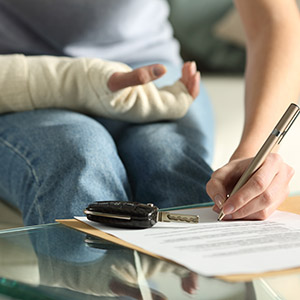
When you’re involved in an accident, the steps you take immediately afterward can have a major impact on your recovery and your ability to pursue compensation. In this article, we’ll overview…
- The importance of documenting accident injuries.
- The types of records you should collect.
- How a lawyer can help strengthen your case from day one.
Why Is Proper Injury Documentation Critical After An Accident?
Proper documentation is essential after a personal injury accident because it helps establish fault, the severity of your injuries, and a clear link between the accident and those injuries. This kind of evidence is central to a solid negotiation with insurance companies or presenting your case in court. It not only strengthens your claim for compensation but also helps show how the accident has affected your day-to-day life.
What Steps Should I Take To Document My Injuries Immediately After An Accident?
Right after a car accident, your first priority should be safety. Move your vehicle out of traffic if it’s safe to do so, and check for injuries. Always call 911, even if injuries seem minor, so that emergency medical services can assess the situation. Once everyone is safe, begin collecting information, keeping these steps in mind:
- Exchange contact and insurance details with the other driver.
- Take photos of the scene, including damage to vehicles, road conditions, visible injuries, and anything else that could be relevant.
- If you’re unable to document the scene yourself, ask someone you trust to do it for you.
- Notify your insurance company.
- Contact an attorney as soon as possible to protect your rights and begin building your case.
What Medical Records Do I Need For A Successful Personal Injury Claim?
To support a personal injury claim, you need medical documentation that clearly links your injuries to the accident and shows the extent of those injuries. Important records include:
- Emergency room reports
- Admission and discharge summaries
- Surgical reports
- Physician notes
- Diagnostic testing results, such as X-rays, MRIs, CT scans
- Physical therapy records
These documents help demonstrate the seriousness of your injuries and the need for ongoing treatment, both of which are key when negotiating compensation.
How Can I Prove Emotional And Psychological Trauma After An Accident?
Emotional and psychological trauma can be more difficult to quantify than physical injuries, but they’re just as real and just as important to document. Proving this type of harm requires clear, consistent evidence that shows how the accident has affected your mental and emotional well-being.
This typically starts with records from licensed mental health professionals, such as therapists, psychologists, or psychiatrists. Diagnoses like anxiety, depression, or PTSD, along with treatment plans and progress notes, help establish a clinical foundation for your claim.
Documentation from therapy sessions can also demonstrate the duration and depth of the emotional trauma you’ve experienced. In addition, testimony from those around you, like family members, friends, or coworkers, can be valuable in showing noticeable changes in your mood, behavior, or personality since the accident. Your own written account plays a role, too, offering insight into how the trauma has impacted your work, relationships, and daily life.
To further support your claim, expert testimony from mental health providers may be used to explain the nature and severity of your distress in medical terms. Even personal tools like journals or diaries can be helpful, especially if they track your emotions and connect them to the aftermath of the accident. All of this evidence works together to paint a fuller, more human picture of the emotional toll the incident has taken.
How Does An Injury Lawyer Help Build A Bulletproof Personal Injury Case File?
Building a strong personal injury case requires more than just telling your story. It demands thorough documentation, legal precision, and strategic organization. An experienced injury attorney plays a vital role in this process by gathering and preserving key evidence, establishing who was at fault, and accurately calculating the full extent of your damages.
The foundation of any strong case begins with evidence. Your attorney will work to obtain detailed medical records, including reports, imaging results, and photographs that show the severity of your injuries. Statements from witnesses who saw the accident unfold can help support your account, while photos or videos from the scene that capture vehicle damage, road conditions, or visible injuries can serve as compelling visual proof. Financial documents, such as pay stubs, bills, and other records, are also essential for showing how the accident has affected your income and created out-of-pocket expenses. Police reports and incident records add another layer of credibility and help establish an official account of what occurred.
Once the evidence is assembled, the next step is proving liability. Your attorney will need to demonstrate that the at-fault party had a legal duty to act with care, that they breached that duty through negligence or misconduct, and that this breach directly caused your injuries. It’s not enough to show that an accident happened. Your lawyer must connect the dots between the other party’s actions and your specific harm.
Finally, a complete case file must include a careful assessment of your damages. This means calculating lost wages, the cost of medical treatment, and other financial impacts, as well as less tangible losses like pain and suffering or emotional distress. The goal is to present a full, well-supported picture of how the accident has affected your life.
How Do You Help Clients Who Feel Self-Conscious Or Overwhelmed About Taking Photos Or Keeping A Journal Of Their Pain?
It’s common for clients to feel uncomfortable about documenting their pain, especially when it involves private photos or personal journaling. As a lawyer, I always start by validating those feelings. It’s perfectly natural to feel self-conscious, and you’re not alone. From there, I help clients see the value in these tools:
- Better treatment: Documenting pain helps healthcare providers understand patterns and triggers, leading to more targeted care.
- Self-awareness: Journaling can give insight into how emotions affect physical symptoms.
- Empowerment: Tracking your own pain can give you a greater sense of control over your recovery.
- Visual progress: Looking back at older photos can show how far you’ve come.
I also offer alternatives. Some clients prefer short notes, while others like to use visual documentation instead of writing. What’s important is finding what works for them. My goal is to build a supportive relationship where clients feel safe and respected. We work together to create strategies that fit their comfort level while still preserving important evidence.
Still Have Questions? Ready To Get Started?
For more information on documenting accident injuries in Kentucky, an initial consultation is your next best step. Get the information and legal answers you are seeking by calling (270) 349-5349 today.
